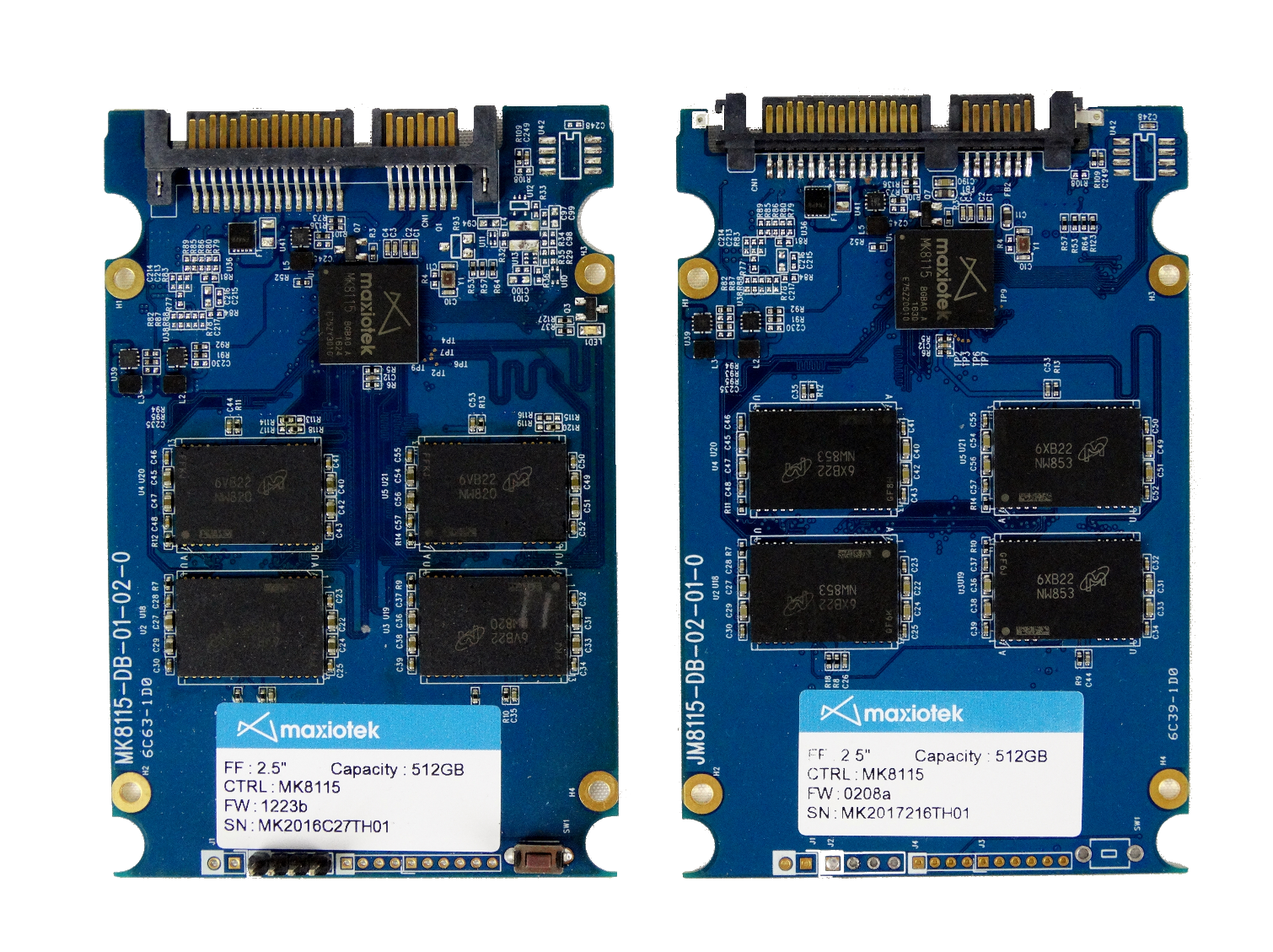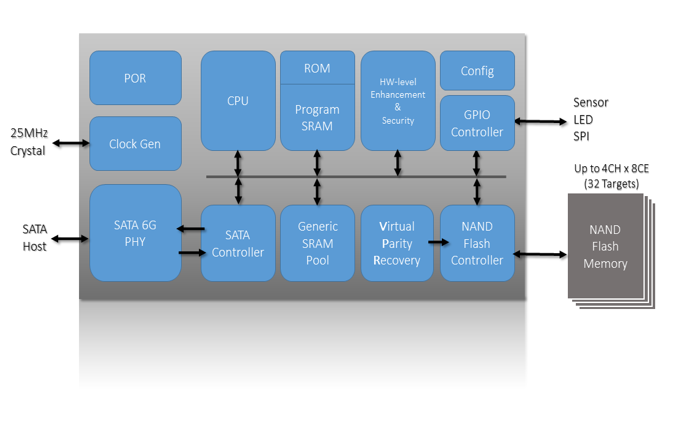Maxiotek MK8115 DRAMless Controller Preview
Features & Specifications
DRAMless SSDs continue to spread across the industry. SSD manufacturers originally designed DRAMless SSDs for point of sale and other light-use environments, but technology advancements have made this class suitable for use in entry-level and mainstream PCs.
Maxiotek hasn't revealed much information about its new MK8115 dual-processor controller. Maxiotek's website has a press release with little information, and it doesn't feature a product page for the MK8115 or any other flash processor under development. This is fairly common for a company coming out of stealth mode, but Maxiotek isn't as new as the name leads you to believe.
We've all heard of JMicron, but few have experienced their flash controller products. The first affordable consumer SSDs came to market with early JMicron-designed controllers, but the early models received mixed reactions. Now JMicron spun the controller team off as a separate entity with a new name and fresh slate. I'd say it's about time to forgive and forget JMicron's early stumbles as we approach the 10-year anniversary of the OCZ Core and other early JMicron-powered consumer SSDs.
Here we are nearly a decade later, and Maxiotek's freshman outing is a new DRAMless controller that focuses on the entry-level market. The new MK8115 is a DRAMless design that supports a wide range of memory technology, from planar (2D) NAND to the latest Micron 3D. This is a product we've seen under development for the last three years, and now it's finally ready to come to market. Maxiotek is very confident in this release, and early signs are positive.
Specifications
Maxiotek didn't publish performance or any other specifications, but the company already has a design win with the MK8115 controller. Adata chose the new silicon for the upcoming Ultimate SU700 SSD and will release the drive in three capacities ranging from 120GB to 480GB. The MK8115 supports a 1TB option, but the NAND shortage has delayed bringing those products to market.
We chose to use the Ultimate SU700's published specifications for the performance comparison chart. Amazon lists two of these models, but the high-capacity model is not available at the time of writing. The Adata Ultimate SU700's specifications indicate 560 MB/s of sequential read throughput across the entire capacity range. The sequential write performance begins at 320 MB/s for the 120GB model and then increases to 520 MB/s for the 240GB and 480GB drives. Random performance reaches up to 80,000 read/write IOPS, but the two low-capacity models drop off due to reduced NAND parallelization.
The Maxiotek MK8115 is a dual-processor design that uses a pSLC layer to cache incoming write traffic. This technique increases performance and allows the SSD to outperform hard disk drives easily. The programmed SLC buffer also increases endurance and reduces costs at all levels. The obvious cost saving comes from the lack of a DRAM component, but there is more to the story. Forgoing the dedicated DRAM channel reduces controller R&D and manufacturing costs compared to controllers designed with DRAM.
Get Tom's Hardware's best news and in-depth reviews, straight to your inbox.
The MK8115 employs a flexible and programmable ECC parity scheme to increase data reliability and throughput. Virtual Parity Recovery (VPR), a proprietary hardware-based redundancy protection mechanism, strengthens reliability and adds another layer of protection to the power-fail protection circuits.
Data security comes in two forms. The hardware-based AES-256 is fairly standard in the industry, but the MK8115 also employs standards-compliant SM4 encryption.
A Closer Look
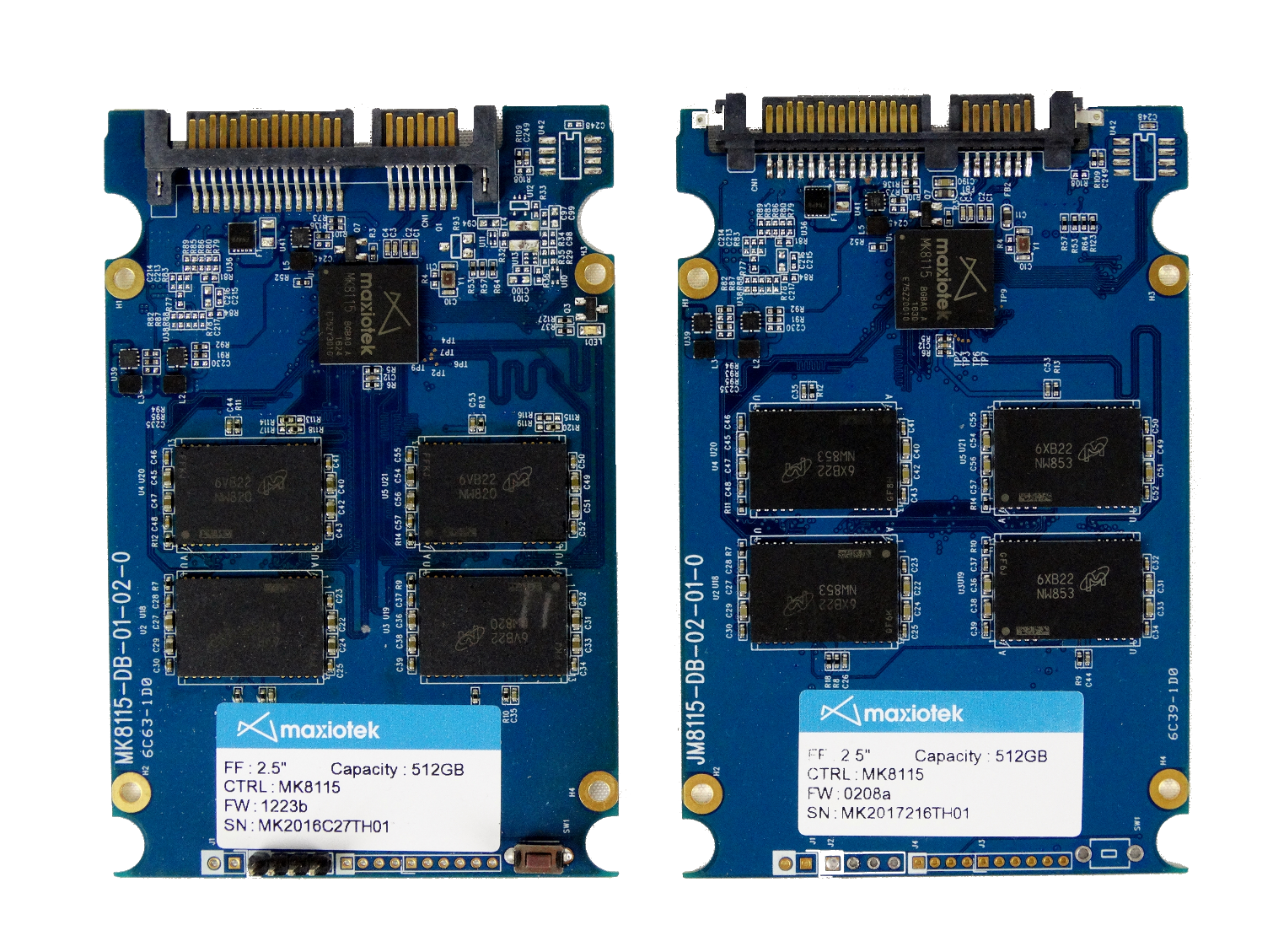
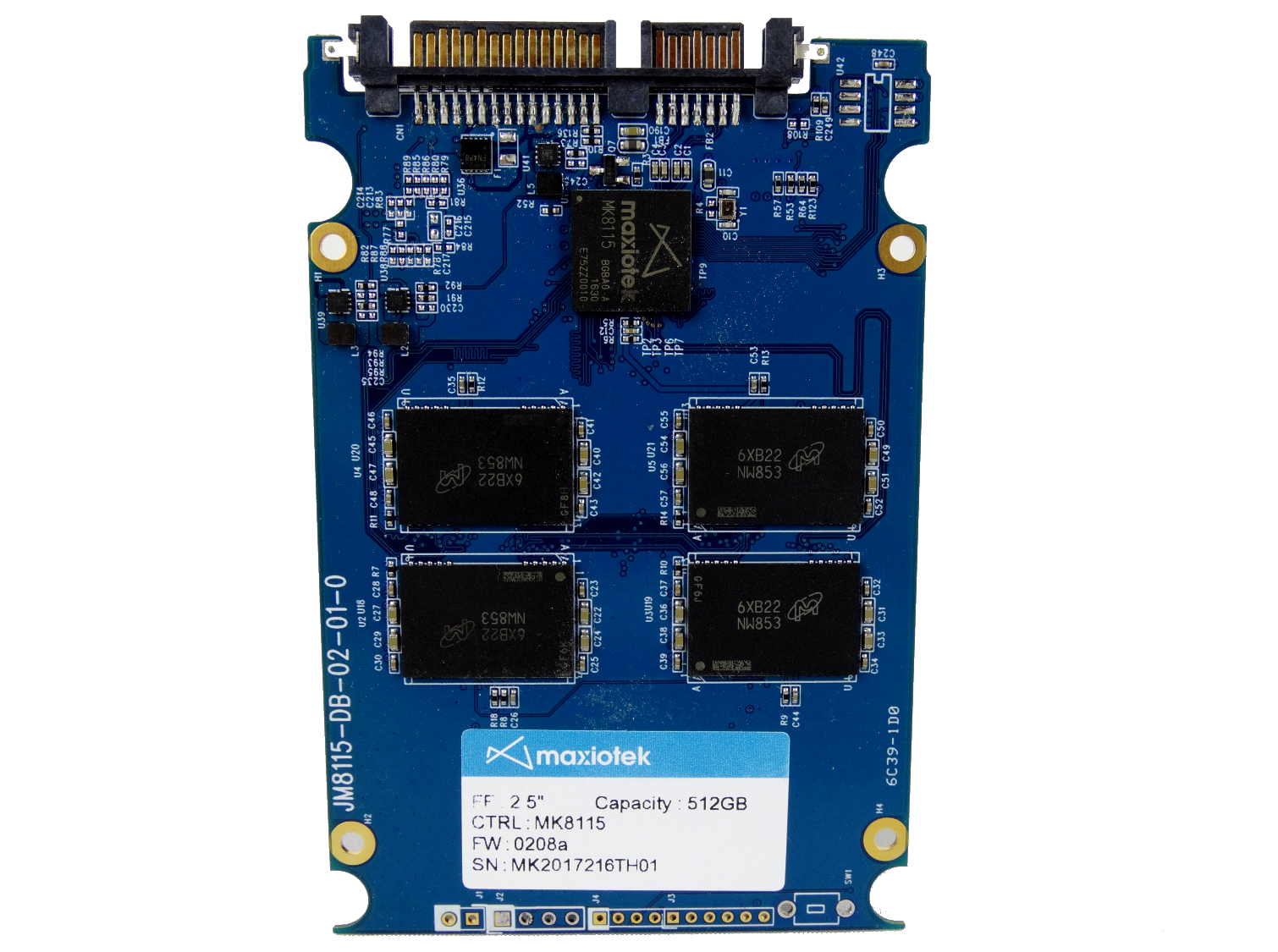
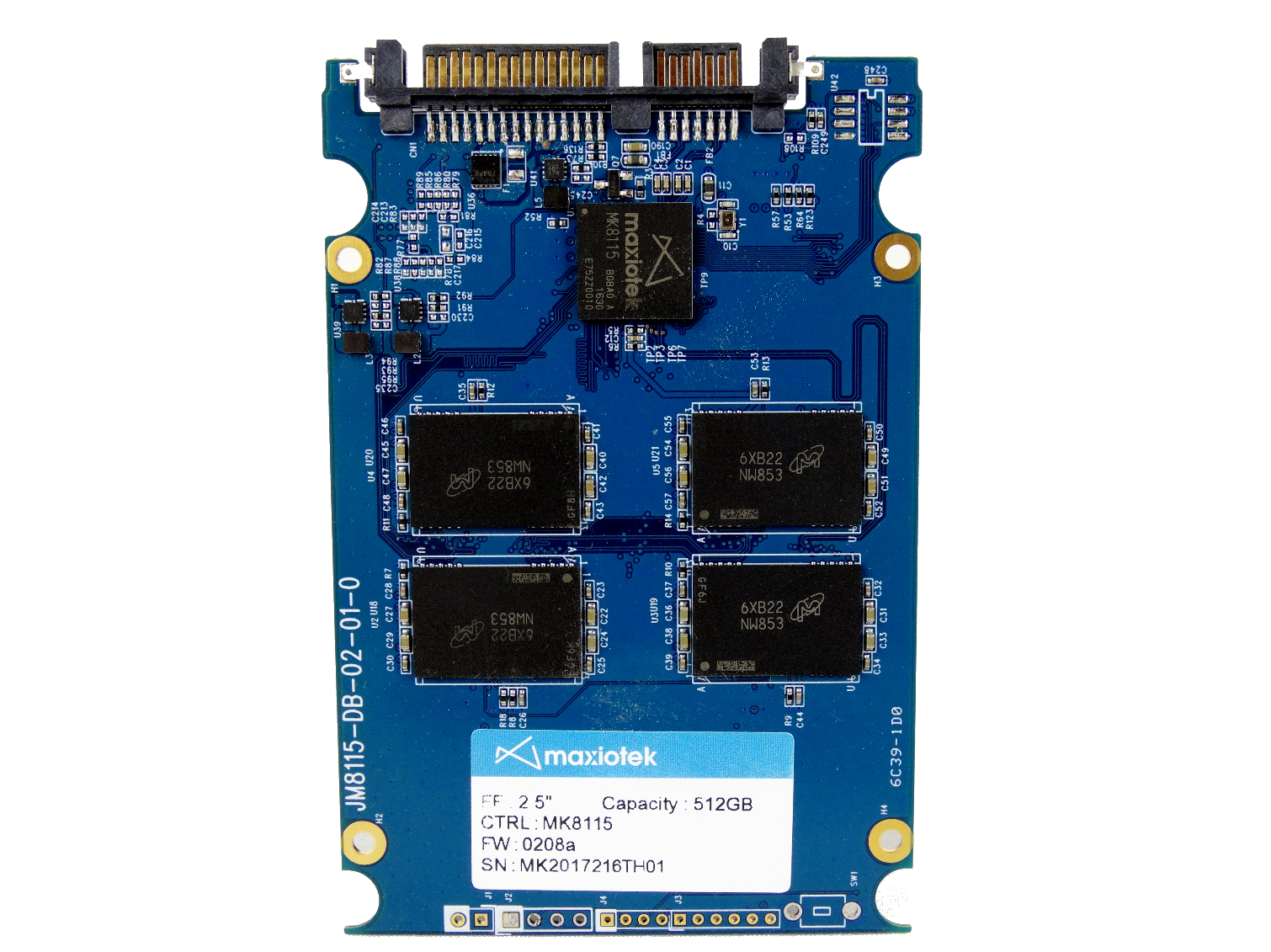

We received two reference design boards directly from Maxiotek. The drives arrived before the Adata Ultimate SU700 announcement, but we had to go back and forth with Maxiotek to learn more.
The MK8115 controller is quite a bit larger than most of the DRAMless controllers we've tested from Phison, Silicon Motion, and Marvell. The large package will help with heat dissipation, but it also increases manufacturing costs. Maxiotek didn't reveal the manufacturing process for the new controller.
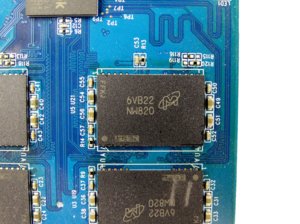
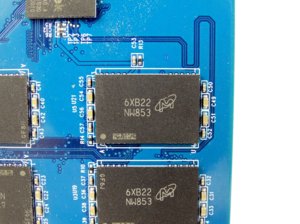
Like many of its previous products, Maxiotek designed the MK8115 for Micron NAND. I have to admit I'm a bit giddy to use the same SSD controller to compare 16nm 128Gbit TLC to the new 3D 384Gbit NAND, so let’s get to testing.
Features
Design
- 4-channel NAND flash memory controller
- Up to 8CE per channel
- 3.3V/1.8V/1.2V power supply
- 12x12mm2 TFBGA package
- Provides 24 pins GPIO shared by manual and automatic self-diagnostics
SATA Controller
- Compliant with Serial ATA International Organization: Serial ATA Revision 3.2
- Support 1-port 1.5/3.0/6.0Gbps SATA I/II/III interface
- Support ATA-8 command set
- Support Partial/Slumber/Device Sleep and dynamic power management
- Support S.M.A.R.T (Self-Monitoring, Analysis, and Reporting Technology)
NAND Flash Controller
- Supports 4 hardware channels with 8 CE pins per channel to NAND flash memory
- Supports Toshiba/Intel/Micron/Hynix/Sandisk 2D-SLC, 2D-MLC, 3D-MLC, and 3D-TLC NAND
- Enhanced endurance by dynamic/static wear-leveling
- Maxiotek’s hardware-based V.P.R (Virtual Parity Recovery)
Security
- Supports AES-256 (Advanced Encryption Standard)
- Supports SM4
Firmware
- Supports transparent Download Microcode SATA firmware update
- Supports 1/2/4/8 banks selected free
- Supports 1/2/3/4 channels selected free
- WriteBooster (pSLC Write Mode)
MORE: Best SSDs
MORE: How We Test HDDs And SSDs
MORE: All Storage Content

Chris Ramseyer was a senior contributing editor for Tom's Hardware. He tested and reviewed consumer storage.
-
HERETIC-1 The sad thing I see about this is it probably costs less than $3 to add Ram,Reply
but by the time you add manufacturer markup- wholesaler markup-retailer
markup it's more like $10-which gives us this extra tier in the race to the
bottom.
Thro Chris's comment re controller complexity if Ram was added might add
a little more..... -
TMTOWTSAC Reply19919859 said:Why are they forcing this on us?
The usual, so marketing can claim "It's an SSD!" to exploit the reputation built by the SSD as a class, while steadily chipping away at everything that gives SSD's better performance in their specific product. -
daglesj Its like VHS recorders in the early 80's weighed 15KG and lasted years. By the time your Dad bought his last one at the turn of the century they weighed 2KG and he threw it out two years later. Reduce the components and make it cheaper every year.Reply -
mapesdhs How very true; a cheap 25 UKP DVD player might last only a few weeks these days. I know someone who went through two of them before finally being persuaded to buy something just a bit better (45 quid Sony or somesuch, faired much better). I have ancient VHS decks that still work fine.Reply -
shrapnel_indie Reply19920161 said:19919859 said:Why are they forcing this on us?
The usual, so marketing can claim "It's an SSD!" to exploit the reputation built by the SSD as a class, while steadily chipping away at everything that gives SSD's better performance in their specific product.
19920561 said:Its like VHS recorders in the early 80's weighed 15KG and lasted years. By the time your Dad bought his last one at the turn of the century they weighed 2KG and he threw it out two years later. Reduce the components and make it cheaper every year.
19920825 said:How very true; a cheap 25 UKP DVD player might last only a few weeks these days. I know someone who went through two of them before finally being persuaded to buy something just a bit better (45 quid Sony or somesuch, faired much better). I have ancient VHS decks that still work fine.
The Audio and Visual industry did this... started a bit slowly in the '80s.... went full tilt in the '90. Killed off or maimed reputations of what was once great companies. Some learned and while still going throw-away, upped the quality just enough to make it palatable to us consumers. It's why the vintage market exists, despite editorials and articles out there that say that vintage isn't better. (it's why a vintage Pioneer SX-1250 receiver that has analog tuning (160W 8Ω or 200W 4Ω, per channel) commands a price tag of $1000+ in good working and cosmetic condition... MORE than its $900 list price when it was brand new in '76)
The PC market, is and isn't the same simultaneously. We enjoy the added speed, power, and features greatly
(look at the price of an IBM 5150, adjusted for inflation, based on today's levels... We can build machines that can do circles around them at the price point they were 35 years ago (this is very good) .... but they aren't built like the tanks they were back then either. Most PC parts just continue to decline in value... The Home Computer market (where the C= 64, C= Vic 20, Amigas, Color Computers, Sinclairs, Ataris, etc. exist) is a little different in prices have stopped going down, and in some cases, have jokers that want 2x - 3x the actual market value.) -
mapesdhs For a long time my main amp was a NAD 3020i. Finally replaced it with an AVR a couple of years ago, a Yamaha 777 or something, so disappointed at the state of modern AV tech; too complicated, too many issues, it needs updates, etc. The NAD still works fine, but I wanted something with video abilities and 4K support for newer tech (HDTV, 4K later). It doesn't look like anybody makes anything these days that Just Works like the NAD does; the complex functions mean software/firmware is involved, which means bugs, and somehow I don't think sw dev people who work on this stuff have the same degree of design rigour as the hw people.Reply
Likewise, the bluray player I bought way back is overly complicated, trying to be an uber home media centre, etc. Annoys me that it takes to long just to turn the thing on and off. Seems like every device is trying to be everything, which means they end up being not good at anything. I bought my brother a 4K TV and a bluray player, the duplication of functionality between them is crazy. Add to that the mess that is 4K bluray support on PCs, hardly worth bothering with.
As for vintage tech, there's no such thing as objective "market value". An item is only ever worth what someone is willing to pay. Auctions for mint ZX80s (especially unused kits) and Jupiter Ace systems can go for really high amounts (I watched an unused ZX80 kit sell for over 1500 UKP); they're hard to find but highly sought after, so people pay a lot. Is an Enterprise 128 worth 160 UKP? Who knows, but that's what I won one for, because I was willing to pay that much to have one for my permanent collection.
If you want real crazy, remember how much those incrediby rare NES games went for, like $40K or somesuch.
Thing is, the old stuff I have generally still works ok (I have over a hundred Sinclair systems, amazing the printers still work), whereas I fully expect my AVR to just die not that many yeas after the warranty runs out. I started collecting vintage tech because it was rising in value, now accounts for about a 3rd of my storage space, and of course valuable items like the Spectrum 128K don't take up much space, so the value-stored-per-unit-volume is quite good (better than the SGI stuff I normally deal with).
I even bagged a couple of Tatung Einsteins, they still work ok. Lots of Acorn systems, Timex, Commodore, etc. The item that's least likely to still work after all these years though is a joystick. :D Most of them were terrible.
Ian.
-
hellwig didn't read the article, what I want to know is, what's the easiest way to avoid these DRAM-less devices?Reply
Sure, I could just buy the most expensive SSD I can find, but that's not a good option (and who's to say people won't sell "premium" SSDs without DRAM anyway)?
What should I look for in the labeling, product description, etc... to make sure my SSD has DRAM? Now, every time I see an SSD on sale, I have to question why it's less expensive.
